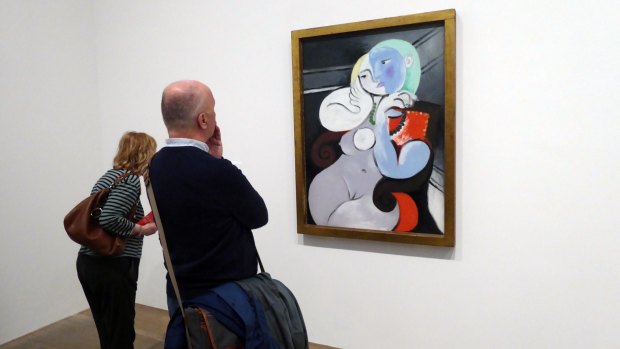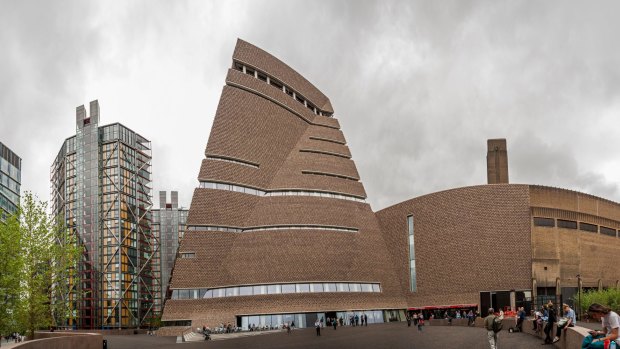This was published 6 years ago
London: Love, Fame, Tragedy - the Tate Modern's first solo exhibition on Picasso

Nude In a Red Armchair by Pablo Picasso at the Tate.Credit: Succession Picasso/DACS London, 2018
On the face of it, life was pretty good for Pablo Picasso at the start of 1932. He'd turned 50 the previous October, he was well-off and famous, living in a grand apartment in Paris' 8th arrondissement with Olga, his Russian ballerina wife, and their son, Paulo. He had a chauffeur-driven limousine, wore tailor-made suits from London's Savile Row and had a secret (much-younger) lover and muse – Marie-Therese Walter, whom he'd wooed after they met five years earlier, when she was 17, outside the Galleries La Fayette department store. Yet the critics wondered if, artistically, Picasso was past it. These suspicions grew when it emerged that Picasso would be curating a retrospective of his life's work – a rare thing for living artists – in the French capital that coming June. But, determined to prove he wasn't yesterday's man, Picasso embarked on an extraordinary flurry of work, and the radical fruits of this prolific "year of wonders" are now being showcased in London at Picasso 1932 – Love, Fame, Tragedy.
It's the Tate Modern's first solo exhibition on (arguably) the 20th century's most influential artist, who was born in Malaga, Spain, but spent most of his adult life in France. The 100-plus exhibits on display come from a variety of sources, including private collections and major galleries like the MoMA in New York and Paris' Picasso Museum.
Promising to "strip away" the myths around Picasso to reveal the man and the artist in "his full complexity and richness", the exhibition flaunts a mind-blowing array of abstract oil paintings, bronze and plaster sculptures and charcoal sketches, along with black and white photographs and newspaper clippings from the year.

Tate Modern.Credit: Alamy
Each room covers a two-month period and charts Picasso's creative frenzy, which played out in his cluttered, bohemian Parisian studio and at the Château de Boisgeloup, an 18th century mansion he'd purchased in the Normandy countryside. The first painting to catch my eye is Woman With A Dagger. Actually completed on Christmas Day 1931, it's a surrealist nightmare of a raging figure stabbing a rival, and conveys Picasso's fears, perhaps, that his wife would discover his clandestine affair with Marie-Therese.
It's rumoured that Olga – one of Picasso's former muses – eventually found out at the June retrospective, when, alongside neoclassical portraits of her and Paulo, there were striking depictions of his new flame. Marie-Therese is undoubtedly the exhibition's dominant personality.
She's here, posing, largely, in varying states of undress, her voluptuous features, aquiline nose and blonde hair wildly exaggerated, with blurring flashes of red, green, blue and lavender also illuminating the paintings. Some of the most celebrated works on display include Nude Woman In A Red Armchair, a sensual portrait painted in high summer, just after her 23rd birthday, and Girl Before A Mirror, a mesmerisingly colourful spectacle that usually graces the MoMA. The most explicit and bizarre painting here is The Dream, in which Marie-Therese is dozing, apparently dreaming about Picasso, with one breast exposed and an erect male member blended into her face. It's the most expensive Picasso ever, with billionaire investor Steve Cohen paying casino magnate Steve Wynn US$155 million for the painting in 2013 (seven years after Wynn accidentally put his elbow through it).
Throughout the exhibition, information panels attempt to delve into Picasso's thought processes. Never resting on his laurels, he was the co-founder of the Cubist movement, but he changed his artistic style almost as often as his mistresses (more muses were to follow Marie-Therese until his death in 1973). Picasso was influenced by many sources: Renaissance-era masters, the impressionism and post-impressionism of Cezanne, Manet, Van Gogh and Matisse, and even far east Asian erotica (there's an example here of a 19th century Japanese painting with an octopus seducing a fisherman's wife). Picasso's mindset is summarised by a quote on the wall: "You start painting, and it becomes something altogether different. It's strange how little the artist's will matters."
Towards the end of 1932, he developed new obsessions, with several pieces showing figures drowning and being rescued. It's believed this could have been sparked by Marie-Therese's ill heath (she'd caught a severe viral infection, and temporarily lost her hair, after swimming in the polluted River Marne). Some say one painting, The Rescue, foreshadows the agony of the mother and child in Guernica, Picasso's iconic 1937 anti-war mural. By the end of the exhibition, even if you're not a huge Picasso fan, chances are you'll feel inspired (or at least fairly impressed). Many artists would be proud of producing a collection as captivating as this over a lifetime. The fact that one conjured it all in 12 months is quite remarkable.
Picasso 1932 – Love, Fame, Tragedy is at the Tate Modern until September 9. Book your tickets and a time-slot online. It's priced £22 ($39) for adults. See tate.org.uk
Steve McKenna travelled at his own expense.
Sign up for the Traveller Deals newsletter
Get exclusive travel deals delivered straight to your inbox. Sign up now.